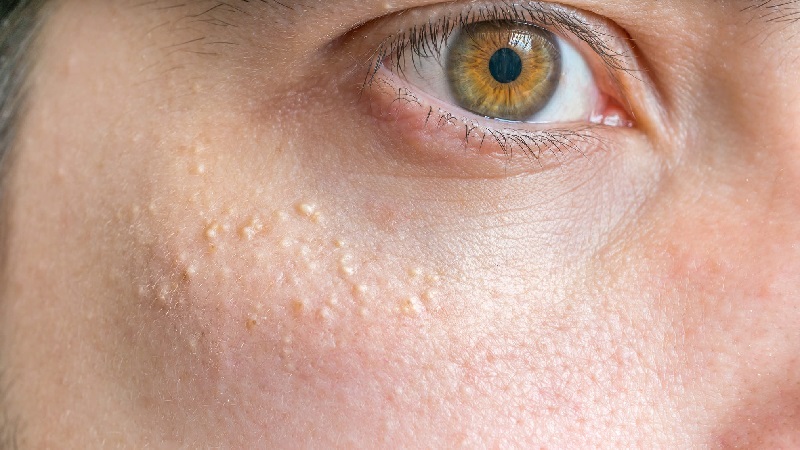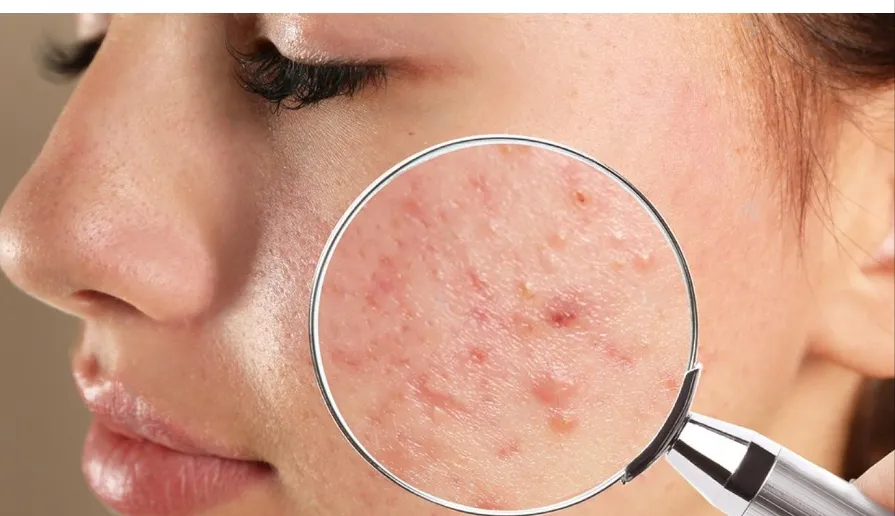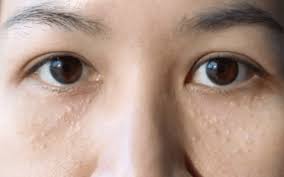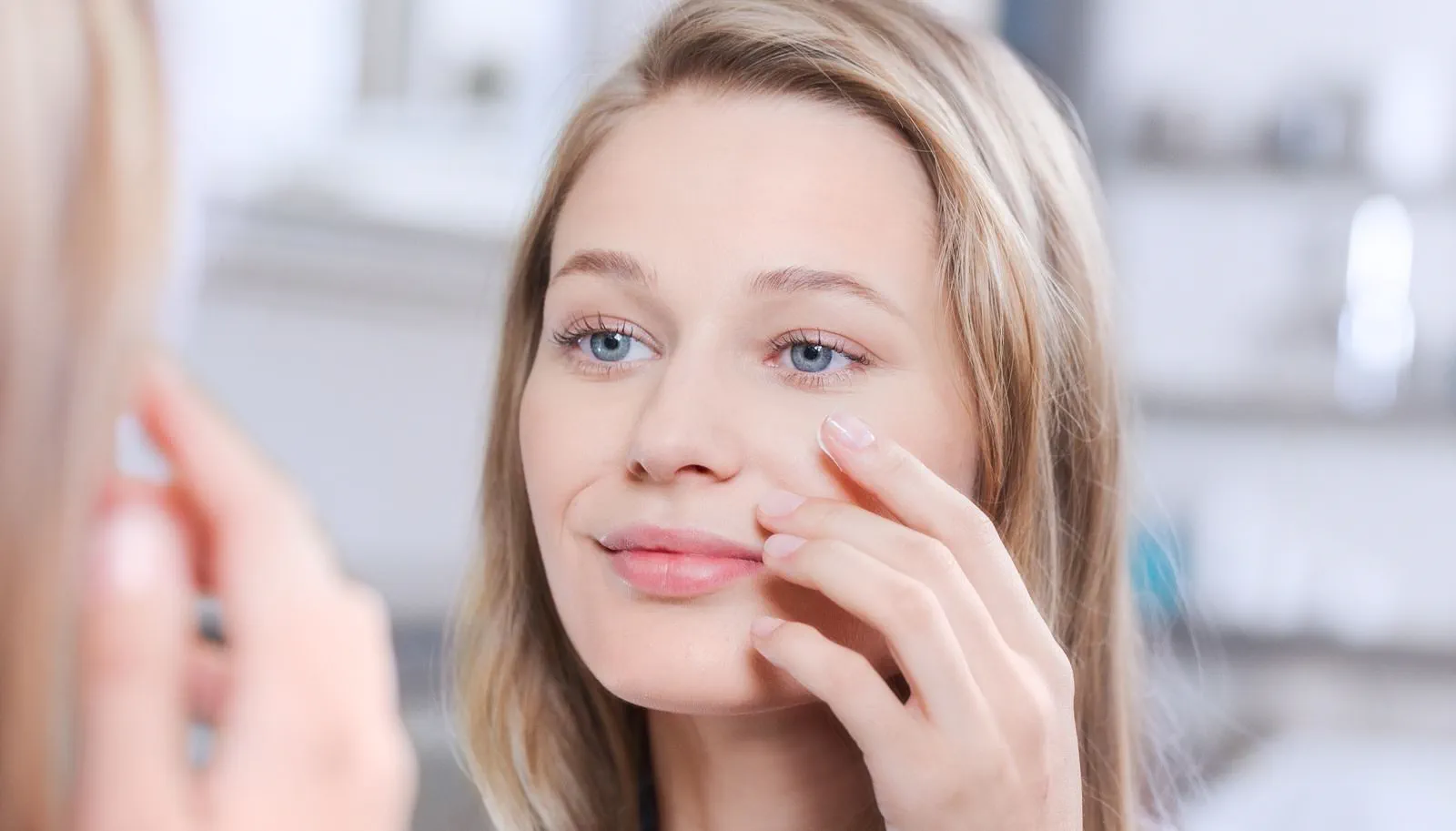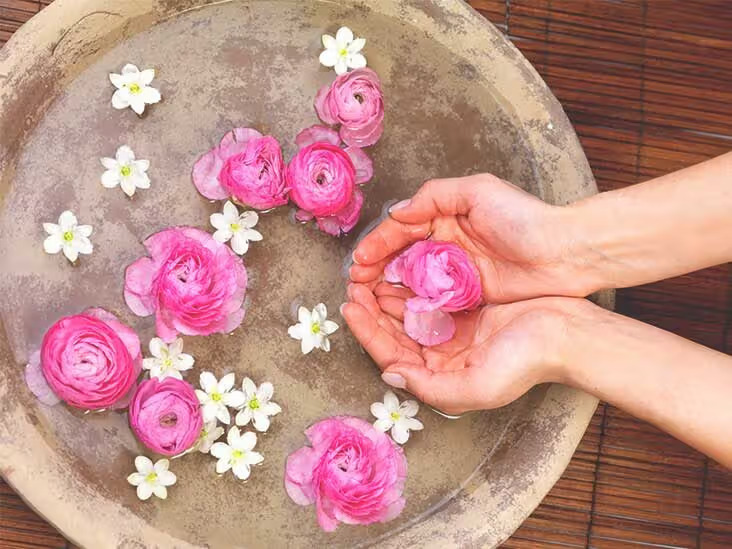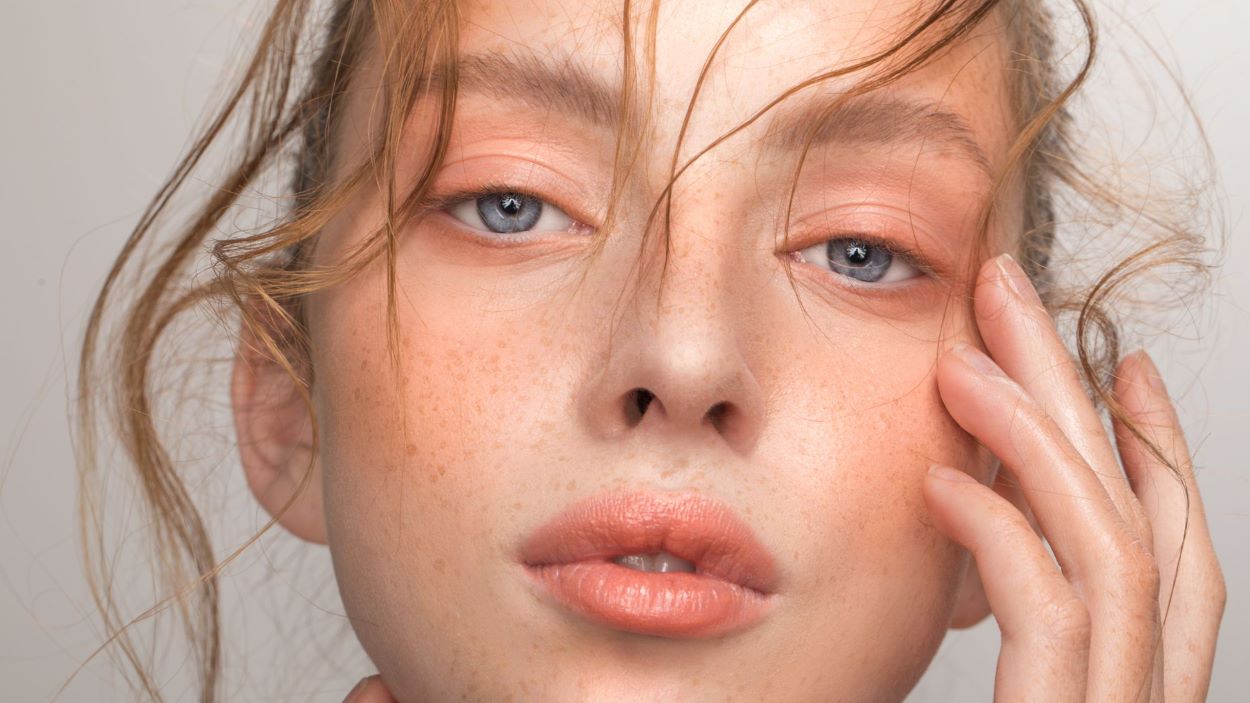Milialar, Tiny Bumps, Big Impact – Welcome to our guide, on Milialar, a skin condition that affects individuals worldwide. In this article, we will explore Milialar, including its symptoms, causes, different types of available treatments, and prevention methods. Whether you are personally dealing with Milialar or simply curious to learn more about it, we are here to provide insights.
Imagine waking up one morning, looking in the mirror, and noticing tiny, white or yellowish bumps on your skin around your face that seem out of nowhere – prompting questions such as, “What are these?” These seemingly harmless bumps may become an object of disquiet for you; their sudden presence poses physical and psychological threats to appearance and self-confidence.
Milialar, commonly referred to as “Milia“, is an all too familiar skin condition that affects people of all ages and backgrounds. Milialar can manifest in clusters of tiny cysts around your nose, cheeks, forehead and chin – some may persist for many years without prompt treatment.
The following sections will delve deep into Milialar by exploring its causes, types, treatment options, and prevention strategies. By the time this article concludes, you'll have gained a comprehensive knowledge of Milia management and ways to enjoy healthier and smoother skin.
Join us as we venture on this expedition to uncover the mysteries of Milialar and how best to manage its symptoms. Whether you are concerned about your newborn's skin, looking for clear solutions as a teenager, or an adult wanting effective remedies – we have something for you here. Let's get exploring!
Table of Contents
What Is Milialar?
Milialar is a skin condition characterized by small raised bumps on its surface that typically appear in clusters and are white or yellow in hue. Milia are most often found on the face near the eyes, nose, cheeks and forehead but can appear anywhere across its entirety.
At first glance, Milia may appear to be small pimples; however, they differ significantly in terms of composition. Milia don't contain pus and don't form around hair follicles or sebaceous glands – rather they form when keratin, an essential protein found in skin hair and nails, becomes trapped beneath its surface and forms cysts beneath the skin's surface.
The appearance of Milia can be quite variable, and they may present as:
1. Tiny Bumps: Milia are generally small, ranging from 1 to 2 millimeters in size. They have a smooth, dome-shaped appearance.
2. White or Yellow Color: Milia are typically white or yellow, which makes them stand out against the surrounding skin.
3. Painless and Non-Itchy: Milia are usually painless and non-itchy, unlike other skin conditions. This means that they won't cause discomfort or irritation.
Milia can be a common condition among newborns, known as neonatal Milia. Newborn Milia often appears shortly after birth and causes concern for parents; fortunately, neonatal Milia typically resolves itself within several weeks without needing special treatments or intervention.
Milia can affect people of all ages, including children and adults. Milia formation in older children and adults may be caused by various factors, including skin damage from injuries like burns, long-term sun exposure or certain skincare products; unlike neonatal Milia forms, these may remain more persistent over time.
Now that you understand what Milia is let's examine its symptoms, causes, and how to differentiate it from other skin conditions.
Symptoms of Milialar
Recognizing Milialar can be quite straightforward due to its distinguishable appearance. Let's dive deeper into its symptoms for a full understanding.
1. Small, White or Yellowish Bumps: The most apparent symptom of Milia is the presence of tiny, dome-shaped, white or yellowish bumps on the skin's surface. These bumps can range in size, typically measuring 1 to 2 millimeters. They often appear in clusters or groups, making them stand out against the surrounding skin.
2. Painless and Non-Itchy: Milia are painless and non-itchy, Unlike some skin conditions. You won't experience discomfort or itching if you have Milia. This is an essential characteristic to distinguish them from other conditions like acne or hives, which can be quite uncomfortable or itchy.
3. Common Locations: Milia primarily affects the facial area, with the most frequent sites around the eyes, nose, cheeks, and forehead. However, they can also appear on other body parts, albeit less commonly. When you notice these small bumps on the face, it's often a clear sign of Milia.
4. Uniform Appearance: Milia have a uniform appearance, making them look consistent in size and shape. This is in contrast to conditions like acne, where you might see a mix of different lesion types, including blackheads, whiteheads, and pimples.
5. Absence of Pus or Redness: One key distinction between Milia and acne is that Milia doesn't contain pus. Acne lesions, on the other hand, often become inflamed, forming red, swollen areas with pus at the center. Milia remains white or yellow and doesn't show signs of inflammation.
6. Age Groups: In infants, Milia is known as “neonatal Milia.” It typically appears within a few weeks of birth and clears up on its own. Milia may develop in older children and adults due to various factors, as discussed earlier. These types of Milia can persist for more extended periods.
7. Cosmetic Concerns: While Milia themselves are generally harmless, they can be a source of cosmetic concern for some individuals. These bumps can affect the smoothness and clarity of the skin, which is why many people seek ways to remove them, especially when they appear on highly visible areas of the face.
Understanding the symptoms of Milia is the first step toward diagnosing it and differentiating it from other conditions. While Milia generally do not pose significant health risks, they can still be bothersome if they affect your appearance. We'll discuss various causes for Milia as well as prevention tips and treatment or removal methods if necessary in the following sections.
Also Read: Natural Home Remedies to Get a Fresh and Younger Skin
What Are the Causes of Milialar?
Milialar may appear as harmless little bumps on the skin, but understanding what causes their formation is key to effectively treating and preventing them. Let's look into Milia's causes to gain more insight.
1. Excessive Dead Skin Cells: One of the primary causes of Milia is the accumulation of dead skin cells on the skin's surface. Think of your skin as a constantly renewing canvas. Old skin cells are naturally shed, making way for new ones. However, sometimes, these old cells don't shed as they should. When they get trapped on the skin's surface, they can clog pores, creating a perfect environment for Milia to form.
2. Sweat and Oil: Another contributing factor to Milia is excessive sweating and the overproduction of skin oil, also known as sebum. When your skin becomes overly sweaty, especially in hot and humid conditions, and when sebum production goes into overdrive, these factors can trap dead skin cells. Combining sweat, oil, and trapped skin cells is a recipe for Milia's development.
3. Incorrect Skincare Products: The products you use on your skin can play a significant role in the development of Milia. Heavy or comedogenic skincare products contain ingredients that can clog pores and hinder the natural shedding of skin cells. If you're using products unsuited to your skin type, you may inadvertently promote Milia formation.
4. Sun Damage: Prolonged exposure to the sun's harmful UV rays can cause damage to your skin. Over time, this damage can make your skin more susceptible to Milia. Sun-damaged skin doesn't shed dead cells as effectively as healthy skin, which can lead to the accumulation of these cells on the skin's surface.
5. Blistering Injuries and Burns: Trauma to the skin, such as blistering injuries or burns, can lead to the development of Milia. In these cases, the healing process can disrupt the natural skin cell shedding, causing dead cells to become trapped and form Milia.
6. Certain Skin Conditions and Medications: Some underlying skin conditions, such as epidermolysis bullosa, can predispose individuals to Milia. Additionally, certain medications and skincare products, particularly those containing steroids, can contribute to the formation of these small cysts.
7. Age and Gender: Milia can affect people of all ages and genders. While neonatal Milia often appears in newborns, primary Milia can form in older children and adults, particularly those with genetic predispositions or other risk factors.
Understanding these causes is the first step towards effectively managing and preventing Milia. By addressing these factors and making appropriate adjustments to your skincare routine, you can significantly reduce the likelihood of Milia development. In the subsequent sections, we'll explore various treatment options and preventive measures to keep Milia at bay.
Tips for Preventing Milia
Milia, those tiny white or yellowish bumps on the skin, may be benign, but preventing their formation is a key step in maintaining clear and healthy skin. Here are some effective tips to help you keep Milia at bay:
Gentle Cleansing: It's crucial to use a mild, gentle cleanser for your daily skincare routine. Harsh cleansers can strip your skin of its natural oils and potentially disrupt the delicate balance of skin cell turnover. Opt for a cleanser that's suited to your skin type, whether it's oily, dry, or sensitive, and use it in your morning and evening skincare regimen.
Non-Comedogenic Products: Opt for skincare and makeup products labelled as “non-comedogenic.” These products are specially formulated so as not to clog pores. By avoiding pore-clogging ingredients, you reduce the risk of developing Milia.
Sun Protection: Protecting your skin from the sun's harmful UV rays is crucial to preventing Milia. Always wear sunscreen with an SPF (Sun Protection Factor) of at least 30. Sunscreen shields your skin from UV damage and lowers the risk of Milia formation.
Regular Exfoliation: Incorporate gentle exfoliation into your skincare routine. Exfoliation helps remove dead skin cells and keeps your skin's surface smooth. It's particularly effective in preventing the accumulation of dead skin cells that can clog pores and lead to Milia. However, remember not to over-exfoliate, as this can irritate your skin. A gentle exfoliant used once or twice a week is usually sufficient.
Hydration: Keeping your skin well-hydrated is critical to preventing Milia. Dry skin is more prone to trapping dead skin cells, which can contribute to Milia development. Use a moisturizer that suits your skin type to maintain the skin's moisture balance. Hydrated skin promotes natural skin cell turnover.
Avoid Heavy Oils: While some facial oils can be beneficial, others can be too heavy for your skin type. Heavy oils can obstruct pores and trap dead skin cells. Opt for lighter, non-comedogenic oils if you want to include them in your skincare routine.
Consult a Dermatologist: If you're prone to Milia or have been dealing with persistent Milia, it's a good idea to consult a dermatologist. A dermatologist can assess your skin, determine the underlying causes, and recommend a personalized skincare routine. They may also provide professional treatments if needed.
Remember, prevention is often the best strategy when it comes to Milia. By following these tips, you can minimize the risk of Milia formation and maintain clear, radiant skin. Incorporating these practices into your daily skincare routine can help you achieve smoother, Milia-free skin. Stay consistent, and your skin will thank you for it.
What Is the Fastest Way to Cure Milialar?
When you're dealing with Milia, the small, white or yellowish cysts on your skin, you might be eager to find the fastest way to get rid of them. While Milia are generally harmless, they can be a cosmetic concern for some. Let's explore some of the fastest and most effective ways to treat Milia.
1. Professional Extraction: One of the quickest ways to get rid of Milia is through professional extraction performed by a dermatologist. Dermatologists have the expertise and specialized tools to remove Milia safely. They make a tiny incision during the procedure and use a sterile instrument to extract the trapped keratin. This process is fast, effective, and minimizes the risk of scarring or infection.
2. Topical Retinoids: Dermatologists often prescribe topical retinoid creams to speed up the removal of Milia. Retinoids promote skin cell turnover, which can help clear the trapped keratin. They are especially effective for treating Milia in adults. It's important to follow your dermatologist's instructions when using these creams.
3. Chemical Peels: Chemical peels are another option to consider for faster Milia removal. During a chemical peel, a chemical solution is applied to your skin, which causes the top layer to exfoliate. This process can improve skin texture and help reduce Milia by removing dead skin cells. Your dermatologist can recommend the appropriate type and strength of chemical peel for your skin.
4. Microdermabrasion: Microdermabrasion is a non-invasive procedure that can quickly exfoliate the top layer of your skin, aiding in Milia removal. It involves using a special device to sand away the outer layer of skin gently. This process can smooth your skin's texture and enhance Milia elimination.
5. Over-the-Counter Exfoliants: While not the fastest option, over-the-counter exfoliants containing ingredients like salicylic acid and glycolic acid can be used to promote skin cell turnover. These products are accessible and can be used as part of your regular skincare routine to help prevent and treat Milia over time.
6. Patience: Finally, it's important to note that Milia may sometimes resolve independently, especially in infants. For adults, they often require treatment to clear up. So, while you're seeking a fast solution, also practice patience if you choose non-invasive options. Be consistent with your skincare regimen, and you may see Milia gradually disappear.
Remember, the fastest way to cure Milia depends on factors such as the condition's severity and skin type. It's essential to consult with a dermatologist who can provide a tailored treatment plan based on your specific needs. While Milia can be frustrating, rest assured that effective solutions are available to help you achieve clear, healthy skin in the shortest time possible.
How Can I Remove Milia Naturally?
If you're looking for natural ways to remove Milia, those tiny white or yellowish cysts on your skin, there are some gentle and non-invasive methods to consider. While natural remedies may take some time to show results, they can be effective for mild cases of Milia. Here are some natural approaches to help you get rid of Milia:
Warm Compress: Applying a warm compress to the Milia can help soften the cyst and make it easier to drain. Soak a clean cloth in warm water and gently press it against the Milia for a few minutes. Repeat this process a few times a day, and over time, the Milia may gradually drain.
Honey: Honey is known for its antibacterial and moisturizing properties. Applying a small amount of raw honey to the Milia and leaving it on for about 15-20 minutes can help soften the skin and promote drainage. Rinse with warm water and pat your skin dry.
Aloe Vera: Aloe vera is a natural skin-soother and can be beneficial in treating Milia. Apply fresh aloe vera gel directly to the Milia and leave it on for 15-20 minutes. Rinse off with warm water and gently pat your skin dry. Aloe vera can help in reducing inflammation and promoting healing.
Tea Tree Oil: Tea tree oil is known for its antimicrobial properties. Dilute a drop of tea tree oil with a carrier oil, such as coconut oil, and apply it to the Milia. This should be done with caution and only for adults since tea tree oil can be strong on the skin. Leave it on for a short time, then rinse off with warm water.
Oatmeal Scrub: You can create a gentle exfoliating scrub using oatmeal. Grind plain oatmeal into a fine powder and mix it with water to create a paste. Gently exfoliate your skin with this paste, focusing on the Milia-affected areas. Be careful not to be too abrasive, as harsh scrubbing can cause skin irritation.
Steam Facial: Steaming your face can help open up your pores and soften the Milia, making it easier for them to drain. Boil water, place your face over the steam (but not too close), and drape a towel over your head to trap the steam. Do this for about 10-15 minutes, then pat your skin dry.
Diet and Hydration: A balanced diet with plenty of water can help maintain healthy skin. Drinking enough water and consuming foods rich in vitamins and minerals can promote skin health. While it won't make existing Milia disappear, a good diet can help prevent future occurrences.
Avoid Picking or Squeezing: One crucial natural way to help Milia resolve is to resist the urge to pick or squeeze them. Popping Milia at home can lead to scarring and infection. If you want them removed, it's best to consult a dermatologist for professional extraction.
Natural remedies may provide relief for mild Milia, but it's important to remember they may not work in more severe cases. Being patient when using these natural methods may take longer to produce noticeable results than expected. If Milia persists or you have any doubts regarding its treatment options, consult a dermatologist to receive proper diagnosis and guidance as to the most suitable course of action in your particular case.
Milia can be an annoying skin issue. Understanding its origins, taking preventative steps and seeking professional treatment are crucial components to achieving and maintaining clear, radiant skin. Remember that consistent skincare practices and natural remedies will play an essential part in reaching healthier and smoother skin!
Consulting a dermatologist is recommended whenever Milia remains persistent, or you're uncertain of your skin condition. With expert knowledge and care from these experts, Milia can be effectively managed and conquered revealing clearer skin.
FAQs
Q1: Can Milia go away on its own?
A1: Milia can sometimes resolve on its own, especially in infants. However, for adults, it often requires treatment to clear up.
Q2: How can I prevent Milia from forming?
A2: To prevent Milia, it's important to practice gentle skincare, use non-comedogenic products, protect your skin from sun damage with sunscreen, and incorporate regular exfoliation into your routine.
Q3: What are the treatment options for Milialar?
A3: Treatment options for Milia include exfoliation, topical retinoids, professional extraction by dermatologists, and chemical peels. The choice of treatment depends on the severity and type of Milia.
Q4: Are there any home remedies for Milialar?
A4: While some people may try home remedies like warm compresses, it's advisable to consult a dermatologist for proper diagnosis and treatment.
Q5: Is Milia the same as acne or pimples?
A5: No, Milia is different from acne and pimples. Acne and pimples involve inflamed or infected hair follicles, while Milia are small, benign cysts filled with keratin.
Q6: Can I pop Milia-like pimples?
A6: It's not recommended to pop Milia at home as it can lead to scarring and infection. Dermatologists have the expertise to safely extract Milia if needed.
May Like: Pam Bondi Weight Loss Story: Diet Plan, Workout, Before & After Photos

